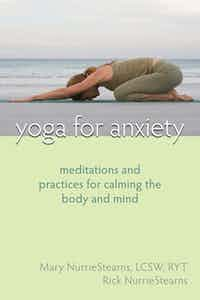By Mary NurrieStearns, LCSW, RYT
Thoughts about anxiety and the physiological experience of anxiety go hand-in-hand. When your clients talk about anticipated difficult events and how they cannot cope with what might happen, their bodies generate a fear response. This is a great therapeutic opportunity. Utilize such moments to teach your clients how to respond to anxiety-producing thoughts.
Pause. Gently, clearly state, “Let’s pause for a moment.” This gets your client’s attention, directing it away from the anxiety-producing thoughts.
Assess. Ask your client to rate anxiety on a scale of zero to ten. If anxiety is over three, ask if he or she would like to feel calmer. With permission, do the following.
Intervene. Instruct your client to take a nice breath in and then blow it out as if blowing out a candle. Then, have the client breathe in and out through the nose. Next, instruct your client to press both feet firmly on the floor while he or she makes a conscious effort to feel those feet on the floor. Finally, instruct your client to look at the floor and focus on what he or she sees there. In less than a minute, your client will feel calmer. If needed, repeat this series one more time.
Educate. Talk about the following teaching points:
Worrying about a scary future and giving such thoughts your attention produces the physiological state of anxiety.
Deep breathing relaxes your body.
Firmly focusing your attention away from thoughts and onto the sensation of your feet on the floor keeps attention away from thoughts and causes your mind to become quiet.
Concentrating your attention on the floor shows you that you can be selective about what you pay attention to. You do not have to give your attention to thoughts that frighten you!
 Mary NurrieStearns, LCSW, RYT, is a psychotherapist and yoga teacher with a counseling practice in Tulsa, OK. She is author of numerous articles on psychospiritual growth and coeditor of the book Soulful Living. She has also produced audio CDs on yoga and meditation as healing practices. She teaches yoga, mindfulness, and meditation, leads transformational meditation and yoga retreats, and teaches seminars across the United States. Her newest book, Yoga for Emotional Trauma, will be released in the summer of 2013.
Mary NurrieStearns, LCSW, RYT, is a psychotherapist and yoga teacher with a counseling practice in Tulsa, OK. She is author of numerous articles on psychospiritual growth and coeditor of the book Soulful Living. She has also produced audio CDs on yoga and meditation as healing practices. She teaches yoga, mindfulness, and meditation, leads transformational meditation and yoga retreats, and teaches seminars across the United States. Her newest book, Yoga for Emotional Trauma, will be released in the summer of 2013.
Want the newest Quick Tips for Therapists delivered directly to your email inbox? Sign up today!

 2024 Peace Playbook: 3 Tactics to Avoid Clashes with Your Partner
2024 Peace Playbook: 3 Tactics to Avoid Clashes with Your Partner